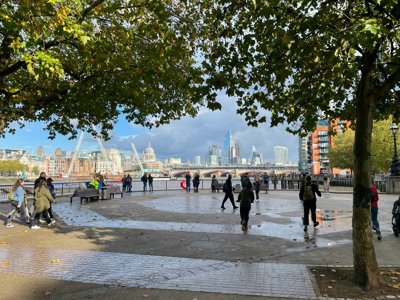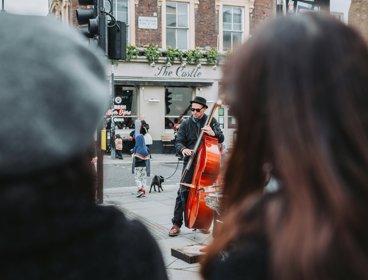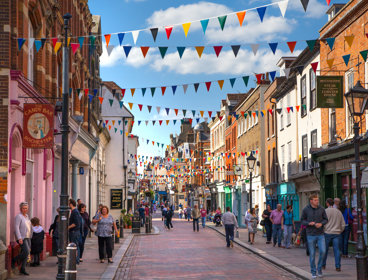A former high school geography teacher, Regan Koch became interested in the public life of cities whilst studying for an MSc in Urban Studies at University College London. Eager to learn more about how public spaces might become more inclusive or democratic, one of his first research projects was the Prince of Wales Junction in 2009. Currently finishing his PhD, Regan has also researched public space through a range of case studies across the United States.
The Prince of Wales Junction
The Prince of Wales Junction in west London (in between Maida Vale and Notting Hill) came to be defined by social problems. Antisocial behavior and fear of crime drove people away. Regenerating the public life of the Junction ended up being much more about finding ways of inviting new uses for the site than about excluding activities that had made it undesirable. This involved using a range of social strategies, or ‘soft regeneration’, to transform a crime hotspot into a pleasant public space.
Phase one of the regeneration plan focused on:
-
Tackling crime and anti-social behaviour (CCTV, policing and security)
-
Reviving the local economy (improving shopfronts, encouraging street events and creating a shopping destination)
-
Improving the local environment (new paving, street lighting, seating and a café)
-
To learn more about the regeneration of the Prince of Wales Junction, read a summary of Regan’s research
First things first, how do you define public space?
I take quite a broad view of public space. To me, any place available to a wide range of people can be considered public. Often, the word refers those owned by the government—the state, city or council perhaps. Yet privately owned spaces can be public too: the pub is a good example, but so is the supermarket or the train.
To me, more interesting questions can be asked if we look at the various public qualities of spaces. Are they open and inclusive to a wide range of people? Do they meet a wide variety of needs, or are they narrowly tailored to serve certain privileged interests? Are problems or conflicts managed in a fair and democratic way?
I should also say that public space is not limited to physical spaces either. Popular ideas, news stories, media and online forums, debates and norms of behaviour are all a kind of public space too, and these affect how we come to live together in cities.
So why is the Prince of Wales Junction in West London an interesting case study?
Well, I should start saying that the Junction is not very big or spectacular, nor is it a well-known public space. Geographers are more often drawn toward big things: mega-developments or mega-events like the Olympics, or big sweeping changes said to be taking place in cities. But among all these big developments, there are loads of in-between spaces and stories– the stuff of the everyday.
What I found interesting—and tragic—was that despite the Junction being located at the very centre of a lively and diverse neighbourhood, it was only used by a very small number of people. This is because it was perceived as dangerous. It was commonly used for drug dealing, prostitution and street-drinking, but not much else. Most area residents avoided the place.
I lived near the Junction for many years. I was aware of its reputation, and avoided it myself at certain times. One day I saw that the pavement was all torn up and there was a sign that said ‘New public space coming soon!’ It got me thinking: who was behind these changes? What were they hoping to achieve? It seemed clear to me that something more positive needed to happen here – something better for the community.
Did the redevelopment make the Junction a better sort of public space?
Simply declaring that a space is now ‘better’ or ‘worse’ is tricky. Doing so begs the question: ‘Better for whom?’ I think these questions need to be answered collectively, taking into consideration a wide range of people and their needs. Creating fair, sensible rules and management routines – and helping to configure spaces so that they largely manage themselves is difficult, but really important.
What the council and the local partnership did at the Junction was change the type of public space that is. In terms of the wider community, a space like this – one that is regularly inhabited by a wide range of people, some working to make money, some shopping, some relaxing over a coffee, some simply walking through – can be crucial to a neighborhood functioning in a way that people come to love and care about.
This is not like many other developments is it?
Well, one important difference is that these improvements were not some massive re-development, and they did not come about through a corporate takeover of the area. Quite often, commercial redevelopments end up ignoring or pushing out certain portions of the local community. Profitability comes to take priority over democracy.
That is not what happened here. This is a story that involves multiple layers of government—national, local council and ward-level—as well as private business and local organisations coming together. There were lots of compromises and negotiations that had to be made. It is about a range of people in the local community taking an active interest in trying to improve where they live.
A second really important point is that inclusion was a key aim of the transformation. It was about trying to attract a greater cross-section of the people in the area to use the space. Rather than further stripping it down, or relying merely on CCTV and the police to control crime, the idea was to create a lively mix of people.
In transforming the public space of the Junction, was there a need to rebrand it?
Well, the local partnership thought so. They changed the name of the area from the ‘Prince of Wales Junction’ to the ‘Maida Hill Market’. It is too early to say if this has really caught on.
Branding can be superficial, of course. There is a risk that it tries to shortcut more important that needs to take place - but not necessarily, and certainly not always. What we call something, how we refer to it, is closely tied to how we perceive it. For years this Junction was branded unofficially as a not very good place. This spot at the very centre of the neighbourhood led some people identify the whole area as ‘troubled’ – which just wasn’t the case.
Just a few years ago, lots of people would not have dreamed of sitting on a bench, shopping for groceries, or having a coffee here. Business entrepreneurs were not interested in renting out the vacant storefronts. Now, things have changed. To this extent, I think the market has been a success regardless of what name eventually sticks.
So, could you put together a recipe of how to successfully transform a public space?
Not really. All spaces are unique in so many ways. I would put understanding the local context ahead of some kind of ‘best-practice checklist’ idea. But for cities or neighborhoods to improve their public spaces, I do think there are some ideas that can be widely applied. To me, the idea of laying a good foundation for public life is an important one. Cities need to allow people of all kinds to make a home in them, to allow people to live together in mutually beneficial ways.
When I say foundation, I am thinking about how you built a good house. First, you first put down some basic building blocks. In terms of public space, some of these are physical—places need to have a surface, a range of objects to function well, and they need to be organised to support activities such as moving through, meeting up, resting, working, eating, and so. You also need foundational things that are less immediately visible—like fair rules and decision-making processes, flexible zoning and licensing laws, good management, caretaking.
How did you go about researching the Junction?
Well, the questions we were interested in required some fine-grained detail. We needed to know things like how routines of use develop over the day. Why do some people decide to stop and sit while others walk through quickly? How do temporary events change the way people relate to the place? You can not get at these things through interviews alone, or through just reading secondary sources.
I knew I needed to find a way to spend lots of time on the Junction, blending in and watching public life unfold. So that is what I did… First, I came to the Junction with a pen, a notebook and a camera. I just started watching how people used the space and talking to a few people. But within a few days I got bored and I actually felt a bit creepy for hanging about so much. I quickly realised I needed a better way of embedding myself there.
So how did you get more involved in the market area?
There were about 18 different market traders in the opening weeks and there was one in particular, who sold fruit and vegetables. He was really good at what he did. He had a beautiful display, he engaged with his customers very well and he was doing what the council was trying to do – animating and enlivening the space, pulling people in.
We talked a bit, and I told him about my research interests. I asked him if I could work on his stall for a few weekends. He was actually thrilled to have some help. I worked for free and became a public character in the marketplace myself. People did not know I was researcher. If they asked, I was happy to talk about it, but most of the time I was just selling fruit and veg. Occasionally, I would stop selling to make a note or two, but I was generally just soaking up the atmosphere.
As an academic and former teacher, how would you recommend students approach research on cities?
I think there needs to be a lot more creativity in how teachers set up class research projects. We should have the courage to let students go after questions that they personally find interesting. I think geographers should take some clues from anthropologists – we should make some time to soak up everything we can about an area for an extended amount of time, and at various time periods. We need to talk to people and do lots of reading up. Really, you need to do lots of this this before you even clarify your research questions.
I also think teachers and students should think about the aims of the research a bit more—besides just passing the class, what might be gained through all your hard work? Is there an interesting question you want to answer, or a problem you would like to see addressed? Is there a way the research might be of benefit to the local area in some way, or contribute to some key debate or discussion?
Do you have any general questions to guide students in their research of public spaces?
I would firstly challenge students to pick a public space in their local area that interests them. They might pick one that is popular, one that is not working well, or one that is going through change in some way. If there is a place that is the focus of a particular controversy or public conversation, that is certainly an interesting place to start. Then, I would encourage them to start by asking how it is actually being used? Who is benefiting from the way it is designed, managed, or populated? Geographers interested in public space often ask questions such as:
-
Is the space inclusive or exclusive?
-
Is the democratic nature of public space being encroached upon in some way?
-
Are there political claims being made in some way?
Through our work on the Prince of Wales Junction, Alan and I came up with three different - but not necessarily separate - ways geographers might want to frame their research of public space. They might want to pay attention to:
-
Materiality: how do material objects and surfaces influence the ways people use a space? These can include lights, trees, pavements, benches, tables…
-
Inhabitation: how do people inhabit a space with their bodies? This involves paying attention to all the things that go on, including whether and how people walk, run, cycle, shop, linger, sit…
-
Atmosphere: what sort of feelings are collectively experienced in a space? There are a whole range of feelings, whether friendliness, sociality, fear, etc that make spaces what they are
And finally, some of the really hard questions about public space are about difficult decisions that have to be made: When are interventions or redevelopments needed, who decides? How do we set rules or that are fair, allow for diversity and the multiple needs of various people? What is allowed and what is not? This often boils down to political decision-making tasks – and it is not easy. Yet these are the kinds of issues geography students can gain a great deal from working on and thinking about.
Regan was interviewed in November 2012.


